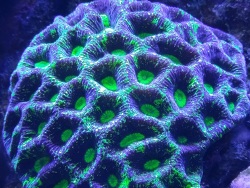Info
Similar Species: Goniastrea aspera and G. peresi, which have smaller corallites. See also Favites russelli, which is usually subplocoid, has smaller corallites, relatively irregular septa and smaller paliform lobes.
Synonymised names
Favia palauensis Yabe & Sugiyama, 1936 · unaccepted > superseded combination (basionym)
Favites palauensis (Yabe & Sugiyama, 1936) · unaccepted > superseded combination
Goniastraea palauensis (Yabe & Sugiyama, 1936) · unaccepted > superseded combination
Goniastraea palauensis var. irregularis Chevalier, 1971 · unaccepted > junior subjective synonym
Goniastraea palauensis var. subtilis Chevalier, 1971 · unaccepted > junior subjective synonym
Goniastraea palauensis var. superficialis Chevalier, 1971 · unaccepted > junior subjective synonym
Goniastrea palauensis (Yabe & Sugiyama, 1936) · unaccepted > superseded combination







 Dr. John Edward Norwood "Charlie" Veron, Australien
Dr. John Edward Norwood "Charlie" Veron, Australien







